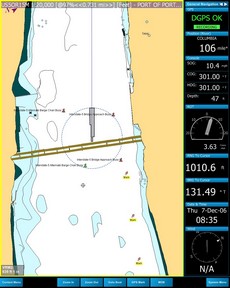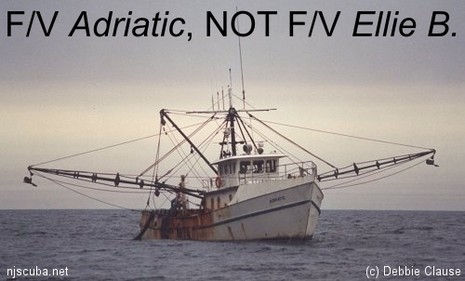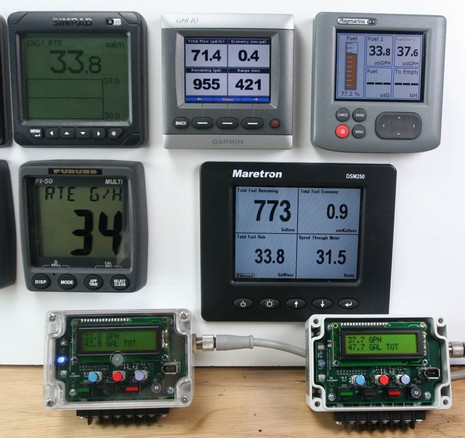Jeppesen ECS, AIS to the max

You really need the full screen above to see what’s going on, but that’s the “tow builder” feature in Jeppesen Marine’s new ECS product, which  previewed at the WorkBoat Show. A tug captain can graphically build a computer model of the whole tow he’s pushing up a river, which is useful in two ways. One is that his plotted vessel will show realistically in the ECS, as shown at right and bigger here . The other is that the ECS can then update the tug’s own Class A AIS transponder so that at least its rough total dimensions are visible to other boats on the river.
previewed at the WorkBoat Show. A tug captain can graphically build a computer model of the whole tow he’s pushing up a river, which is useful in two ways. One is that his plotted vessel will show realistically in the ECS, as shown at right and bigger here . The other is that the ECS can then update the tug’s own Class A AIS transponder so that at least its rough total dimensions are visible to other boats on the river.
Jeppesen’s commercial marine Web site is still a bit skimpy on this product but there is a PDF describing a Precision Approach System (PAS) that will integrate with the ECS. “Hyper-accurate” GPS combined with secure wireless will let tugs and locks share all sorts of valuable data, probably including the detailed tow configurations. The overall product—ECS, PAS, and more hinted at—is called Jeppesen Marine OnBoard and is obviously adaptable, at least in part, to deep sea commercial vessels. The ECS, by the way, may or may not be based on Nobeltec code, I can’t tell, and Jeppesen’s purchase of C-Map still seems to be in its quiet period.













I would guess not based on Nobeltec as the UI looks much cleaner and I can’t imagine building a commerical quality product from the Nobeltec code base.
Coupled with the C-map purchase it looks like Jeppesen plans to become the “Jeppesen” of marine navigation the same way it dominates aviation. If they deliver the same quality that they do for aviation it will really raise the bar for recreational marine navigation products which will benefit us all.
The chart part of the 2nd image looks exactly like Admiral to me. In particular the font used in the gray bar showing the map scale, as well as the transparency of that bar is the same as in Admiral Navview. The chart area itself also looks like Nobeltec; for example the North indicator, chart colors etc. are the same.
The font used for the data area is another clue.
Obviously the rest of the UI is different, especially the window widgets.
There are a couple of interesting points for the inland market on this system, instead of lat, long, the system is giving the position in river mile marker and speed is in mph instead of knots. The system AIS will also calculate where target and vessel will meet in the river using the river line as the distance. (ie, the system knows the course of the vessel and target (river) and just needs to calculate speed.)
There’s no doubt that Jeppesen is serious about this market, which is something they announced over a year ago. I would not be surprised if there is some “Nobeltec” code in this, but this display interface looks more “commercial” and “cleaner.” The tow builder function is very similar to the capability of the Furuno 2117 radar, which I think is installed on a lot of river boats.
Obviously the chart for the demonstration is a “Transas” chart. I can only think this is temporary; and, that Jeppesen’s purchase of C-Map is part of the company’s long term planning that will eventually see them sever their relationship with Transas. The real challenge for any company will be finding good source data to build electronic river charts from. The Corps of Engineers is under funded and behind schedule — just like NOAA. Just to give an example of how difficult a challange this is; the plates for the Lower Mississippi River chart book were stored in New Orleans. Notice the word “were.” Now think of Katrina and flooding.
I’m not sure what Ben means by “Hyper-accurate” GPS. Is there a new publicly available GPS frequency only he or Jeppesen knows about, or is “Hyper-accurate” simply marketing hype for Differential GPS, which has been on the rivers for a number of years? Perhaps Ben can enlighten us on that point?
There are commercial systems on the market that give sub-centimeter accuracy using GPS and a referenced base station correction. I believe they start at $10,000 and go quickly up in price. They would need to install a base station on each lock in the system.
I was just quoting Jeppesen with the “hyper-accurate” but suspect they mean the Omnivision subscription differential javacat mentioned. I didn’t know about the base station part, but there’s links to the gear in this Zeus Drive entry:
https://panbo.com/yae/archives/001270.html
The actual systems used are called Real Time-Kinematic (RTK) RTK has centimeter level accuracy and is mainly used by surveyors I believe. Magellan among others sells these types of systems.
http://pro.magellangps.com/en/products/product.asp?PRODID=49